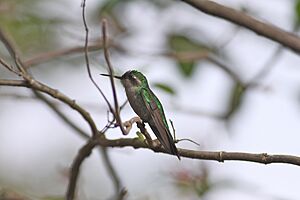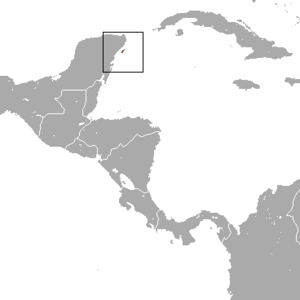Cozumel emerald facts for kids
Quick facts for kids Cozumel emerald |
|
|---|---|
 |
|
| Conservation status | |
| Scientific classification | |
| Genus: |
Cynanthus
|
| Species: |
forficatus
|
 |
|
| Cozumel emerald range | |
| Synonyms | |
|
Chlorostilbon forficatus |
|
The Cozumel emerald (Cynanthus forficatus) is a beautiful hummingbird found only on Cozumel Island. This island is located off the coast of Mexico's Yucatán Peninsula. It belongs to a group of hummingbirds often called "emeralds" because of their shiny, green feathers.
Contents
What's in a Name?
The Cozumel emerald's scientific name has changed a few times. Scientists sometimes move species around as they learn more about them. It was first called Chlorostilbon forficatus.
Later, some experts thought it was a type of golden-crowned emerald. Others even linked it to the blue-tailed emerald. Today, most major bird groups agree on its name: Cynanthus forficatus.
What Does it Look Like?
The Cozumel emerald is a small bird. Males are about 9 to 10.5 centimeters (3.5 to 4.1 inches) long. Females are a bit smaller, around 8 to 9.1 centimeters (3.1 to 3.6 inches). Both males and females weigh about 2.5 grams (0.09 ounces). That's about the weight of two paper clips!
Male Cozumel Emerald
Male Cozumel emeralds have a black beak with a red tip. Their head is a bright golden or golden-green color. The rest of their upper body is a slightly duller golden-green. Their belly and chest are a super shiny, metallic golden-green. They also have little white fluffy feathers on their legs.
Their tail is long and deeply split, like a "V" shape. It's blue-black or black with a blue shimmer. The two or three feathers in the middle of the tail have dark brownish-gray tips.
Female Cozumel Emerald
Female Cozumel emeralds have a black upper beak and a red lower beak with a black tip. Their upper body is a bright metallic green or bronze-green. They have a white stripe behind their eye and dark cheeks.
Their belly and chest are light gray. Their tail is not as long or deeply split as the male's. The middle feathers are metallic green or blue-green. The next two pairs have a blue-black or black band near the end and white tips. The two outermost pairs have white on the outside edge near the base. They also have a wide black band and white tips.
Where Does it Live?
The Cozumel emerald lives almost entirely on Cozumel Island. This island is off the coast of Mexico's Yucatán Peninsula. There was one sighting on Isla Mujeres, which is about 90 kilometers (56 miles) north. This suggests they might visit other nearby islands sometimes.
They like to live in "scrub" areas and low forests. They also enjoy places where the forest is growing back after being disturbed.
Daily Life
Movement
The Cozumel emerald stays on Cozumel Island all year long. It does not migrate to other places.
Feeding
Scientists don't know all the details about how the Cozumel emerald finds its food. However, they believe it eats in a similar way to its relatives, like the Canivet's emerald. These birds visit many different flowering plants to drink nectar. They also eat small arthropods, which are tiny insects and spiders.
Breeding
Not much is known about the Cozumel emerald's breeding habits. We don't know when their breeding season is or what their nests look like.
Vocalization
The calls of the Cozumel emerald are similar to those of its close relatives. They make "dry, rattling and chattering calls."
Is it Safe?
The IUCN (International Union for Conservation of Nature) has listed the Cozumel emerald as a species of "Least Concern." This means it is not currently in danger of disappearing.
There are an estimated 20,000 to 50,000 adult Cozumel emeralds. Their population seems to be stable. No major threats have been found for this bird. It is quite common on Cozumel Island. Human activities probably don't have a big impact on them. This is because they can live in areas that have been changed by people.


